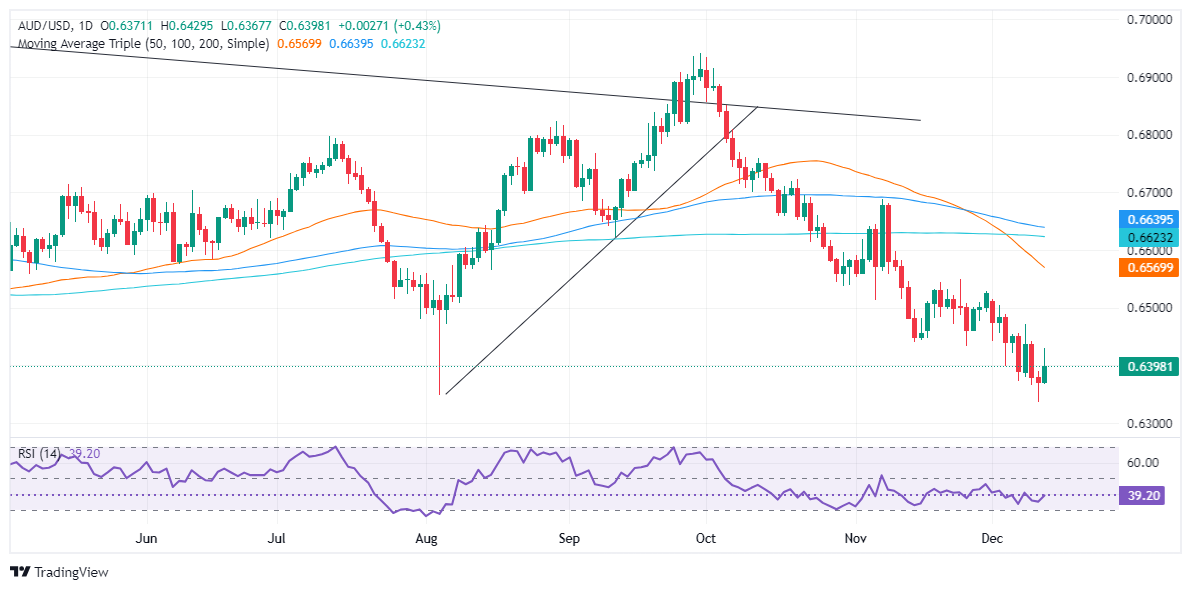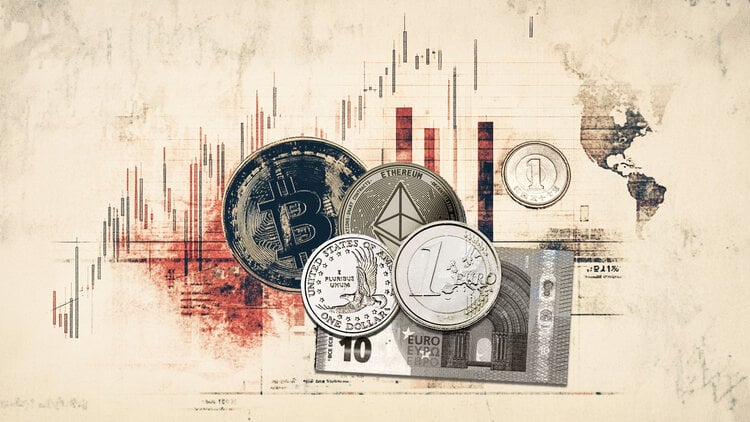- AUD/USD rises to 0.6392, boosted by weak US labor market reports.
- US initial jobless claims hit a two-month high, fueling speculation of continued Fed policy easing.
- Australian employment exceeds expectations with 35,600 jobs added in November, unemployment drops to 3.9%.
The Australian Dollar regains some ground on Thursday against the US Dollar, following the release of US employment data. The US Bureau of Labor Statistics (BLS) revealed that the labor market is weakening further , suggesting that the Federal Reserve could continue to ease policy. AUD/USD is trading at 0.6392, up 0.36%.
AUD/USD trimmed gains after mixed US economic data
The BLS revealed that initial jobless claims for the week ending December 7 rose to a two-month high of 242,000, surpassing estimates of 220,000, according to Bloomberg. At the same time, the November Producer Price Index (PPI) revealed by the same government agency showed that headline inflation on the producer side rose 3% year-on-year, from 2.4%, above the government’s forecasts. 2.6%, while the core PPI rose 3.4% year-on-year, beating projections of 3.2%, from 3.1%.
Following the data, the US currency failed to gain traction. The US Dollar Index (DXY), which tracks the performance of the dollar against six other currencies, remains firm at 106.79, up 15%.
During the Asian session, Australian employment figures for November surpassed estimates of 25,000, reaching 35,600, while the unemployment rate fell from 4.1% to 3.9%, below forecasts of 4.2% .
The swaps market cut the odds of a rate cut in February to 50%, from 70% before the data. However, the RBA took a more dovish stance, saying “the Board is gaining some confidence that inflation is moving sustainably towards target.”
AUD/USD Price Forecast: Technical Outlook
AUD/USD rose sharply and hit a daily high of 0.6429 following the Australian data, but trimmed its gains as strong US PPI numbers suggest the Federal Reserve would take a cautious approach to cutting interest rates .
Momentum turned slightly bullish in the short term, but overall, the trend is tilted lower as the Relative Strength Index (RSI) is bearish.
If AUD/USD buyers reclaim 0.6400, the next resistance would be the 0.6500 level. A break of the latter will expose the 50-day SMA of 0.6568.
Conversely, if sellers intervene and drag prices below the December 11 daily close of 0.6336, the pair could fall to 0.6300, before targeting the October 23, 2023 low of 0.6270.
The Australian Dollar FAQs
One of the most important factors for the Australian Dollar (AUD) is the level of interest rates set by the Reserve Bank of Australia (RBA). As Australia is a resource-rich country, another key factor is the price of its largest export, iron ore. The health of the Chinese economy, its largest trading partner, is a factor, as is inflation in Australia, its growth rate and the Balance of Trade. Market sentiment, that is, whether investors bet on riskier assets (risk-on) or seek safe havens (risk-off), is also a factor, with the risk-on being positive for the AUD.
The Reserve Bank of Australia (RBA) influences the Australian Dollar (AUD) by setting the level of interest rates that Australian banks can lend to each other. This influences the level of interest rates in the economy as a whole. The RBA’s main objective is to maintain a stable inflation rate of 2%-3% by adjusting interest rates up or down. Relatively high interest rates compared to other major central banks support the AUD, and the opposite for relatively low ones. The RBA can also use quantitative easing and tightening to influence credit conditions, with the former being negative for the AUD and the latter being positive for the AUD.
China is Australia’s largest trading partner, so the health of the Chinese economy greatly influences the value of the Australian Dollar (AUD). When the Chinese economy is doing well, it buys more raw materials, goods and services from Australia, which increases demand for the AUD and drives up its value. The opposite occurs when the Chinese economy does not grow as fast as expected. Therefore, positive or negative surprises in Chinese growth data usually have a direct impact on the Australian Dollar.
Iron ore is Australia’s largest export, with $118 billion a year according to 2021 data, with China being its main destination. The iron ore price, therefore, may be a driver of the Australian dollar. Typically, if the price of iron ore rises, the AUD also rises as aggregate demand for the currency increases. The opposite occurs when the price of iron ore falls. Higher iron ore prices also tend to result in a higher likelihood of a positive trade balance for Australia, which is also positive for the AUD.
The trade balance, which is the difference between what a country earns from its exports and what it pays for its imports, is another factor that can influence the value of the Australian dollar. If Australia produces highly sought-after exports, its currency will gain value solely from the excess demand created by foreign buyers wanting to purchase its exports versus what it spends on purchasing imports. Therefore, a positive net trade balance strengthens the AUD, with the opposite effect if the trade balance is negative.
Source: Fx Street
I am Joshua Winder, a senior-level journalist and editor at World Stock Market. I specialize in covering news related to the stock market and economic trends. With more than 8 years of experience in this field, I have become an expert in financial reporting.








